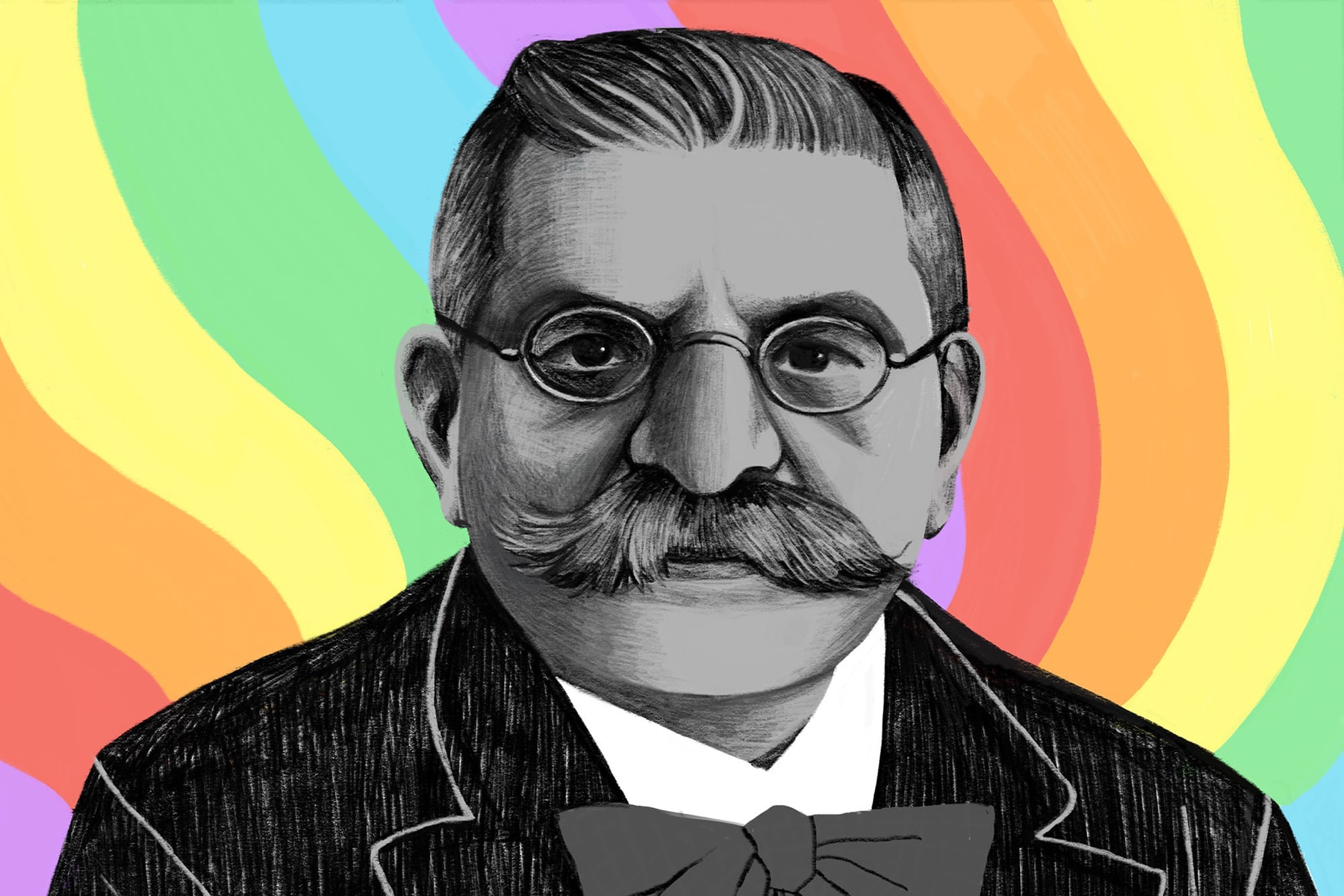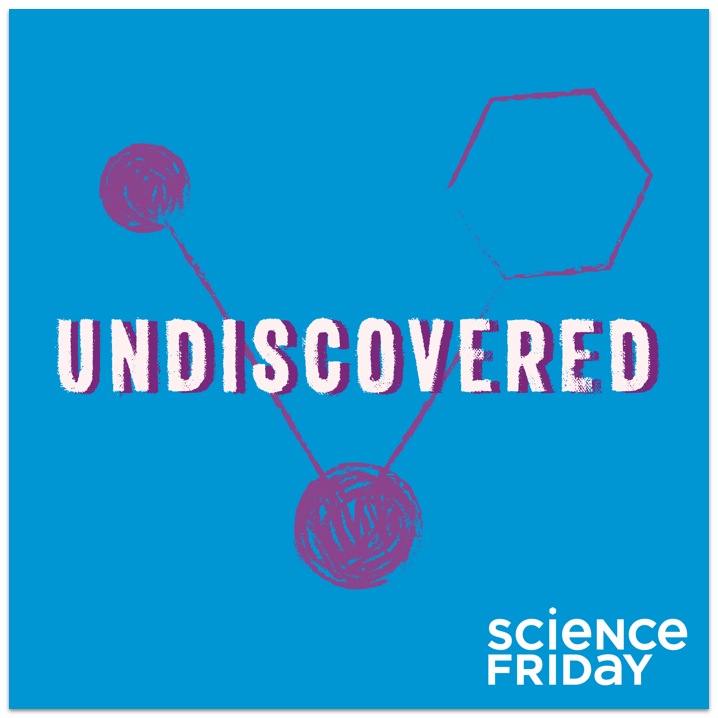Magnus Hirschfeld, The ‘Einstein Of Sex’
7:06 minutes

 Undiscovered is a podcast from Science Friday and WNYC Studios about the left turns, missteps, and lucky breaks that make science happen. We tell the stories of the people behind the science, and the people affected by it. Listen to more episodes here.
Undiscovered is a podcast from Science Friday and WNYC Studios about the left turns, missteps, and lucky breaks that make science happen. We tell the stories of the people behind the science, and the people affected by it. Listen to more episodes here.
Before Alfred Kinsey began his work on human sexuality, there was an earlier pioneer of sexual studies: Magnus Hirschfeld. At the turn of the 20th century, Hirschfeld moved from Magdeburg, Germany, to Berlin, where he established his Institute for Sexual Science, and founded the first gay rights organization. His fame became so great that he became known as the “Einstein of Sex.” His goal was to prove, scientifically, that homosexuality was rooted in biology—and thus liberate gay men and lesbians from oppressive German laws. But his ideas soon fell into the wrong hands, with tragic consequences.
In the latest episode of SciFri’s new spinoff podcast, “Undiscovered,” co-hosts Annie Minoff and Elah Feder tell his tale, and debate whether scientific knowledge really does lead to justice, as Hirschfeld had hoped. Subscribe here to listen to the full episode.
Annie Minoff is a producer for The Journal from Gimlet Media and the Wall Street Journal, and a former co-host and producer of Undiscovered. She also plays the banjo.
Elah Feder is the former senior producer for podcasts at Science Friday. She produced the Science Diction podcast, and co-hosted and produced the Undiscovered podcast.
IRA FLATOW: You’re listening to Science Friday. I’m Ira Flatow. Next up– if you’re always left wanting more after Science Friday wraps up each week, I hope you’ve heard about our brand new podcast Undiscovered. It’s a new weekly show about the left turns and the false starts behind great scientific discoveries. And the first episode covered data science and Chinese internet censorship. Last week we met a geologist searching for meteorites in Antarctica, and this week it’s– that’s the great part about the show– something totally different. Our co-hosts Annie Minoff and Elah Feder have a brand new story for us. Welcome back to Science Friday.
ELAH FEDER: Thanks for having us back.
ANNIE MINOFF: It’s good to be here.
IRA FLATOW: OK. So what’s this episode all about?
ANNIE MINOFF: Yeah. So as a gay person, I’ve been interested for a long time in the science of sexual orientation, especially you know science that looks at whether people were quote unquote “born that way”. Things like looking for the so-called gay gene. This episode goes way back before a lot of this recent research. We go to pre-nazi Germany and we tell the story of a sex researcher named Magnus Hirschfeld, who was possibly the first person to try to prove, using science, that there was something biological underpinning homosexuality. It was a pretty radical idea back then.
ELAH FEDER: And you know, Magnus was using the science at his disposal, right? So now we might talk about genetics or even epigenetics, but back in his day scientists could see chromosomes under the microscope but they still weren’t sure if they had anything to do with heredity. So Magnus was really all about documenting and recording things like physical traits or behavioral traits, trying to see what gays and lesbians might have in common or might be different than the rest of the population. And so in this clip that I’m going to play from our episode, this is our German friend Tobias. And he brings Magnus to life in this episode. So here he is reading from Magnus’ scientific research. And you’re going to hear that some of his science doesn’t age that well today, it’s a little bit ridiculous. Here we go.
TOBIAS: Ever since Ulrichs, in the literature you meet with the statement that homosexuals cannot whistle. This does not agree with the results of our statistics. Among 500 homosexuals, 385– 77%– could whistle. Only a few could truly whistle well.
IRA FLATOW: What if there’s no whistling?
ELAH FEDER: I was not aware of this particular stereotype that was apparently going around in 1914 that gay men couldn’t whistle, but Magnus was aware and he thought this was a myth that needed busting. And so that is what he did.
ANNIE MINOFF: Sort of. He showed that apparently 77% of gay men could whistle, but but not well. But he found that among lesbians that the whistling arts were very strong, which was nice to hear. But this episode isn’t, you know, about making fun of Magnus or this old timey science, because a lot of the things that he did made a lot of sense. And some of it we’re still doing.
ELAH FEDER: So for example, he was interested in whether homosexuality ran in families. Was it a heritable trait? Or you might remember a few years ago there were a bunch of studies looking at the correlation between finger length ratios and sexual orientation. They seemed to find a connection in women. And he did he did stuff like that. He was looking at hip to shoulder ratios. It was pretty pioneering sex research.
IRA FLATOW: Yeah. And that’s what people are trying to find, some sort of body, like you say, symbols that you could point to that someone was gay.
ANNIE MINOFF: Right.
IRA FLATOW: Or something like that. He’s from that old school.
ELAH FEDER: He was.
ANNIE MINOFF: Yeah and like way before Kinsey. I mean, when you think pioneering sex research you might think Kinsey, but Magnus was a huge deal in his day even though he’s not very well known today. He was, in the 1930s, touring the world lecturing about sexuality in China and India. The American press actually called him the Einstein of sex.
ANNIE MINOFF: Apparently Einstein had visited shortly before.
IRA FLATOW: Well, you know, I’ve heard of Kinsey. I’ve heard of Al Hirschfeld, who was the cartoonist, but never Magnus Hirschfeld.
ANNIE MINOFF: No relation? Maybe relation? But he also had a sex Institute. I mean, he was like an institutional figure in Berlin, where he was from.
ELAH FEDER: Yeah. It was in a big villa in the middle of town, or the Tiergarten, which is like Berlin’s Central Park. And they had medical examination rooms. They had a library. They had a sex museum that was apparently a big tourist attraction.
ANNIE MINOFF: I can’t imagine why.
ELAH FEDER: And also, this institute offered a really– they had a public education mission. Here is Robert Beachy, professor of history at Yonsei University.
ROBERT BEACHY: They had a little box at the edge of the property and people could anonymously insert slips of paper with questions about sex or any sort of sexual issue that they had. And then people were invited in and these different slips of paper would be read out loud and then responded to. And so there were questions about things like, I don’t know, premature ejaculation. And you know, how effective it was to use condoms for preventing pregnancy. You know, just lots of relatively mundane questions. But it was supposed to be a public service.
ELAH FEDER: So I mean basically the equivalent of the anonymous question box maybe you had in middle school health class. Same idea.
IRA FLATOW: So what was his motivating force? Why did he do this?
ANNIE MINOFF: Yeah, good question. Magnus was gay himself. He was both a scientist and an activist. And he was really hoping that his science would lead to greater acceptance of gay and lesbian people. In particular, he really wanted to take down this anti-sodomy statute in the German criminal code at the time. So he founded what is actually considered the first gay rights organization. It was called the Scientific Humanitarian Committee, because at the core of their work was a lot of Magnus’ science. Here is a clip of Robert Beachy, the historian, again.
ROBERT BEACHY: The motto of the organization was through science to justice. His very simple, and maybe in some ways profound, idea was that if there were adequate scientific study, if people really just understood, they would change their view. And ultimately this would also have the effect of changing the law.
ANNIE MINOFF: So this was really Magnus’ MO, right? You know, from science to justice. He felt like if he could get his science out into the world, he would be making the world a better place.
ELAH FEDER: Yeah. Which has a nice ring to.
ANNIE MINOFF: It’s a beautiful idea.
ELAH FEDER: It’s a nice idea. But as we end up seeing in Magnus’ story, you can do science. You can hope that it’s going to be used in one way, and it can work out very differently. And his story ultimately is a pretty tragic one.
IRA FLATOW: You have my attention. I’m sitting here whistling. All right, so listen to the episode. We will to find out what happens. Undiscoveredpodcast.org– that’s where you can go to the website. Or you can Apple podcast or do whatever you do with your audio.
ELAH FEDER: Wherever you find your podcasts, we are there. Undiscovered.
IRA FLATOW: Thank you, Elah and Annie.
ANNIE MINOFF: Thanks, Ira.
Copyright © 2017 Science Friday Initiative. All rights reserved. Science Friday transcripts are produced on a tight deadline by 3Play Media. Fidelity to the original aired/published audio or video file might vary, and text might be updated or amended in the future. For the authoritative record of ScienceFriday’s programming, please visit the original aired/published recording. For terms of use and more information, visit our policies pages at http://www.sciencefriday.com/about/policies/
Christopher Intagliata was Science Friday’s senior producer. He once served as a prop in an optical illusion and speaks passable Ira Flatowese.